The smell of wine, oh how much more delicate, cheerful, gratifying, celestial and delicious it is than that of oil. François Rabelais (1495-1553)
Friday, March 30, 2007
A quick trip to Philadelphia: will I be able to taste some Pennsylvania wines?
Pennsylvania's winemaking history goes back to the 1600s with William Penn the first to plant Vinifera vines in 1684. Unfortunately, none of them survived.
Nowadays, Pennsylvania is still primarily a dairy producing state but winemaking has been growing rapidly since the adoption of the Farm Winery Act in 1968, which allowed wineries to sell wine directly to the public. Only about a quarter of the grapes grown in the state are Vitis vinifera. The majority are Native American (Vitis labrusca) and French-American hybrids (including Chambourcin, Seyval Blanc, Vidal Blanc, Vignoles) that are planted for their hardiness and resistance to disease.
Pennsylvania wine is not easy to find. 95 percent of the production is sold directly at the winery, 4 percent through the state-owned liquor stores, and only 1 percent is sold out of state.
Therefore , the best way to discover Pennsylvania wine is to visit the wineries along some of the state's well documented wine trails such as the Berks County Wine Trail, the Brandywine Valley Wine Trail, or the Lehigh Valley Wine Trail.
Unfortunately, I will not have the time for such visits during this trip, so I just hope that I will find some local wines by the glass wherever I go for dinner.
Technorati tags: wine food & drink
Monday, March 26, 2007
A delicious wine for a great bouillabaisse
But last week, a friend of mine showed me her simplified recipe. Her bouillabaisse ended up being rich in flavor and surprisingly easy to prepare. First, make a fish broth with fish trimmings (such as fish frames and fish heads). This can be done ahead of time. Then, cook onions, garlic, tomatoes, leeks, fennel in olive oil. Add orange peel, fennel seeds, bay leaf, saffron, and the fish broth. Let it boil and reduce. Finally, strain the soup, add fish fillets (halibut, red snapper), scallops, then mussels. Serve with parsley, croutons, and rouille.
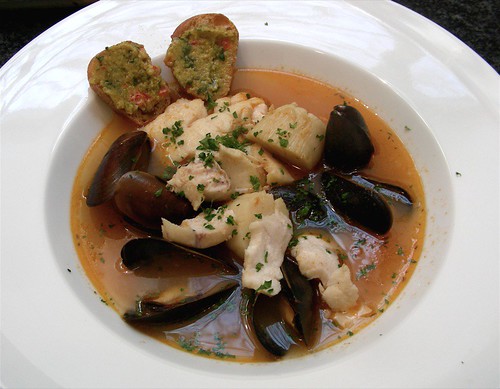
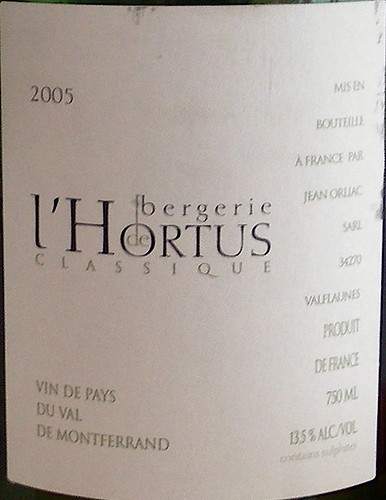 With the bouillabaisse, we had a white from the Languedoc, the 2005 Bergerie de l'Hortus Classique Blanc. Domaine de L'Hortus is a 60 hectare estate located in the valley between the Pic Saint Loup and the Montagne de l'Hortus. Bergerie de l'Hortus is the domaine's second label. Made with young vines, the wine was an unusual blend of Chardonnay, Viognier, and Sauvignon Blanc. It had a bright golden color with aromas of stone fruits and white flowers. On the palate, it was deliciously lush, ripe, and mouthfilling with a touch of sweetness on the finish. Everybody agreed: it worked wonderfully well with the bouillabaisse.
With the bouillabaisse, we had a white from the Languedoc, the 2005 Bergerie de l'Hortus Classique Blanc. Domaine de L'Hortus is a 60 hectare estate located in the valley between the Pic Saint Loup and the Montagne de l'Hortus. Bergerie de l'Hortus is the domaine's second label. Made with young vines, the wine was an unusual blend of Chardonnay, Viognier, and Sauvignon Blanc. It had a bright golden color with aromas of stone fruits and white flowers. On the palate, it was deliciously lush, ripe, and mouthfilling with a touch of sweetness on the finish. Everybody agreed: it worked wonderfully well with the bouillabaisse.Technorati tags: wine food & drink
Tuesday, March 20, 2007
Pinot Locale
 I was there recently with a good friend of mine as we were both low on Santa Cruz Pinots. We bought a couple of bottles of our favorite, the Muccigrosso Pinot Noir and while we were there, we also tasted the 2004 Silver Mountain Vineyards Pinot Noir Tondre's Grapefield that was available at the tasting bar. The wine was not from the Santa Cruz Mountains but from the nearby Santa Lucia Highlands. It was nevertheless delicious: fragrant, well structured, with a long finish. We walked out of the store with arms full, but we were happy.
I was there recently with a good friend of mine as we were both low on Santa Cruz Pinots. We bought a couple of bottles of our favorite, the Muccigrosso Pinot Noir and while we were there, we also tasted the 2004 Silver Mountain Vineyards Pinot Noir Tondre's Grapefield that was available at the tasting bar. The wine was not from the Santa Cruz Mountains but from the nearby Santa Lucia Highlands. It was nevertheless delicious: fragrant, well structured, with a long finish. We walked out of the store with arms full, but we were happy.Technorati tags: wine food & drink
Wednesday, March 14, 2007
WBW #31: wines in boxes, are they any good?
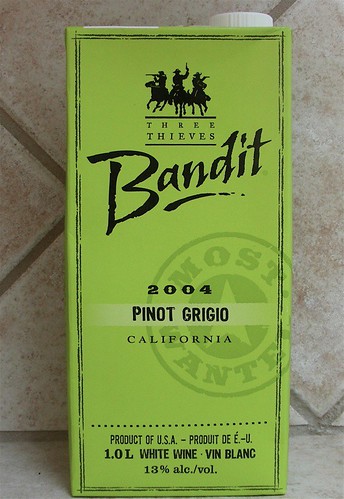 The first wine I tried was the 2004 Three Thieves Bandit Pinot Grigio sold in a one-liter Tetra-pack for $7. “We stole money from the bottle and gave it to the wine” claims the producer Three Thieves on the box. According to the winemaking notes, the wine is a California blend of 80% Pinot Grigio, 12% Sauvignon Blanc, 4% Chenin Blanc, 4% Muscat. It was cold-fermented at 50F in stainless steel to retain the fresh, fruity aromas of fermentation and was not permitted to undergo a secondary malolactic fermentation to ensure crisp acidity.
The first wine I tried was the 2004 Three Thieves Bandit Pinot Grigio sold in a one-liter Tetra-pack for $7. “We stole money from the bottle and gave it to the wine” claims the producer Three Thieves on the box. According to the winemaking notes, the wine is a California blend of 80% Pinot Grigio, 12% Sauvignon Blanc, 4% Chenin Blanc, 4% Muscat. It was cold-fermented at 50F in stainless steel to retain the fresh, fruity aromas of fermentation and was not permitted to undergo a secondary malolactic fermentation to ensure crisp acidity. The big surprise was that the wine was actually very pleasant. It had a very pale yellow color and a subtle nose of honeyed pear. On the palate, it was dry and crisp with a creamy mouthfeel and an aftertaste of apple. Transfer the wine into a regular glass bottle and serve it to your friends on a warm summer day: they will love it!
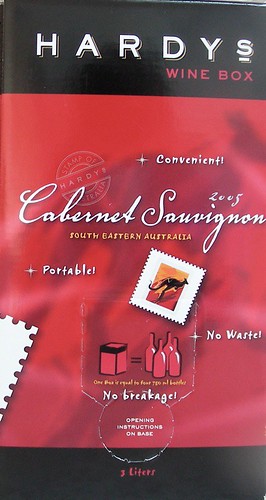 I also tried a red wine from South Eastern Australia, the 2005 Hardy's Stamp of Australia Cabernet Sauvignon, sold in 3-liter box for $16. In Australia, this kind of wine is pretty common as more than 50 percent of all wine consumed in the country is from boxes.
I also tried a red wine from South Eastern Australia, the 2005 Hardy's Stamp of Australia Cabernet Sauvignon, sold in 3-liter box for $16. In Australia, this kind of wine is pretty common as more than 50 percent of all wine consumed in the country is from boxes.The bag-in-the-box system was actually created 40 years ago by the Scholle Corp. There is a vacuum-sealed plastic bag inside the cardboard box that keeps the wine in a sterile environment. As wine is poured from the tap, the bag collapses, blocking air from reaching the wine and preventing oxidation. However, the wine should be consumed within a month after opening.
So I poured the wine from the tab. It had a dark red/purple color, a heady nose of sweet black berries, a soft and full texture and a finish of ripe fruit and licorice. Although not the most exciting wine, it is a solid everyday drinking wine. But 3 liters is a lot; I may use some of it in the coming days in a beef stew.
Technorati tags:: wine food & drinkwine blogging wednesday wbw wbw31
Monday, March 12, 2007
A new trend in France: low alcohol and reduced alcohol wines
Winemakers have different ways to produce low alcohol wines. This can be done naturally by using varietals such as Grenache and Cinsault that can reach maturity without accumulating too much sugar. They can also use yeasts that do not completely transform sugar into alcohol, leaving a certain amount of residual sugar in the wine. Other methods are more technology-based. Some remove the sugar from the must (Redux procedure). Others remove the alcohol from the fermented wine (reverse osmosis).
Now, do these high tech reduced alcohol wines still taste like wine? According to the French wine magazine La Revue du Vin de France, only few are successful, most are disappointing.
Now I am curious to try some of these Plume wines. Unfortunately, I don't think they are imported in the US yet. So maybe next time I go to France, I'll let you know...
Technorati tags: wine food & drink
Tuesday, March 06, 2007
Tasting the wines of Piedmont
Piedmont, which means foot of the mountain, is almost completely encircled by the Alps. Winters are cold and snowy, summers are warm and dry, and in the fall during the harvest season, the weather is often cool and foggy. Besides its wines, the region is famous for its cuisine rich in flavors, featuring game, porcini and white truffles.
When we think about Piedmontese wines, we think of the intensely flavorful Barolos and Barbarescos, and maybe the fruity Barberas, but few of us have tried the region's excellent whites that made from ancient, indigenous, sometimes almost extinct grapes.
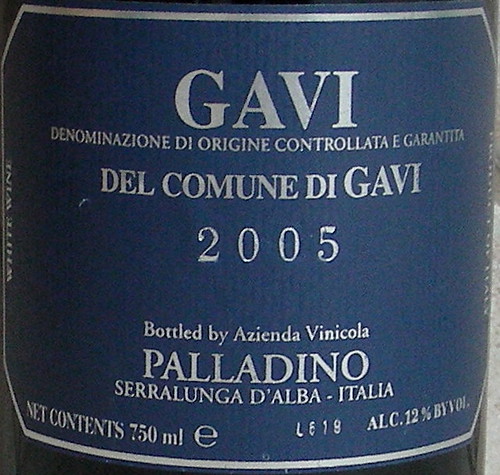 We tasted two whites from Piedmont. The first one was the 2005 Palladino Gavi di Gavi. Run by the Palladino family, the Azienda Vinicola Palladino is the oldest of the area. The Gavi di Gavi is one of the producer's most popular wines. Gavi is a wine made exclusively from the Cortese grape, an indigenous variety from the hills of southeastern Piedmont. The wine had a golden color with grapefruit and citrus aromas on the nose. On the palate, it had a crisp acidity and a fat mouthfeel. It was excellent served as an aperitif and should also work well with a fish dish in a light cream sauce.
We tasted two whites from Piedmont. The first one was the 2005 Palladino Gavi di Gavi. Run by the Palladino family, the Azienda Vinicola Palladino is the oldest of the area. The Gavi di Gavi is one of the producer's most popular wines. Gavi is a wine made exclusively from the Cortese grape, an indigenous variety from the hills of southeastern Piedmont. The wine had a golden color with grapefruit and citrus aromas on the nose. On the palate, it had a crisp acidity and a fat mouthfeel. It was excellent served as an aperitif and should also work well with a fish dish in a light cream sauce.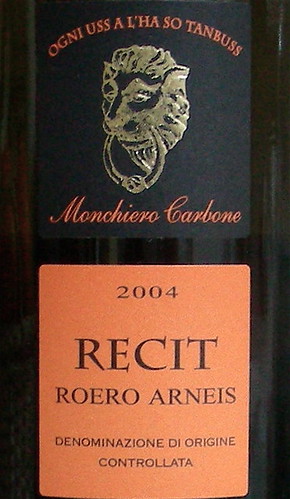 Our second white was the 2004 Monchiero Carbone Roero Arneis Recit. Because of its thin skin, Arneis, which means little rascal in the local dialect, is hard to cultivate and hard to vinify. By the 1960s, Arneis was nearly extinct and was often vinified and blended with Nebbiolo. But thanks to a few Barolo producers, the varietal was saved from extinction. The Roero Arneis Recit is unwooded and packaged in a dark bottle to prevent premature aging. It had a pleasant fragrant nose. The palate was full-bodied with a rich mouthfeel and a distinctive stony finish. It was absolutely delicious with the Vitello Tonnato dish that one of our friends had brought, a Piedmontese specialty with veal, tuna, capers, and anchovies.
Our second white was the 2004 Monchiero Carbone Roero Arneis Recit. Because of its thin skin, Arneis, which means little rascal in the local dialect, is hard to cultivate and hard to vinify. By the 1960s, Arneis was nearly extinct and was often vinified and blended with Nebbiolo. But thanks to a few Barolo producers, the varietal was saved from extinction. The Roero Arneis Recit is unwooded and packaged in a dark bottle to prevent premature aging. It had a pleasant fragrant nose. The palate was full-bodied with a rich mouthfeel and a distinctive stony finish. It was absolutely delicious with the Vitello Tonnato dish that one of our friends had brought, a Piedmontese specialty with veal, tuna, capers, and anchovies.Then we tasted the following reds:

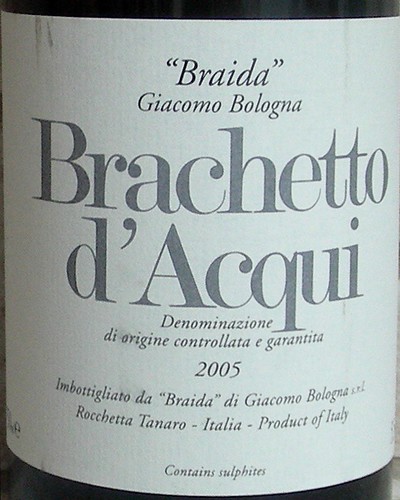 • 2005 Braida di Giacomo Bologna Brachetto d'Acqui: Braida means stretch ball and is a local Piedmontese sport. It was also the favorite pastime and the nickname of Giacomo Bologna's father. While Barbera d'Asti is the winery's main production, it also produces some amount of Brachetto d'Aqui, a low alcohol, sweet, red sparkling wine, named for the Brachetto grape as well as the Acqui district near the town of Asti. Showing a light red/pink color, the Braida Brachetto d'Acqui had a fruity nose of raspberry and blackberry. Slightly fizzy and semi-sweet on the palate, it was fresh and light with an alcohol content of only 5.5%. This Brachetto left nobody indifferent: some guests really loved it, others had hard time finishing their glasses: too sweet, too fizzy, too light.
• 2005 Braida di Giacomo Bologna Brachetto d'Acqui: Braida means stretch ball and is a local Piedmontese sport. It was also the favorite pastime and the nickname of Giacomo Bologna's father. While Barbera d'Asti is the winery's main production, it also produces some amount of Brachetto d'Aqui, a low alcohol, sweet, red sparkling wine, named for the Brachetto grape as well as the Acqui district near the town of Asti. Showing a light red/pink color, the Braida Brachetto d'Acqui had a fruity nose of raspberry and blackberry. Slightly fizzy and semi-sweet on the palate, it was fresh and light with an alcohol content of only 5.5%. This Brachetto left nobody indifferent: some guests really loved it, others had hard time finishing their glasses: too sweet, too fizzy, too light. • 2004 Ruggeri Corsini Dolcetto d'Alba: founded in 1843 by the Besserat family, Podere Ruggeri Corsini is a husband and wife operation located in Monforte d'Alba, one of the main communes in the Barolo Appellation. The wine is made from Dolcetto, which means the little sweet one, an easy to drink, medium-bodied, and fruity varietal. It had a bright reddish-purple color and a floral nose of violets. On the palate, it was round with mineral flavors and a fresh peppery finish.
• 2004 Ruggeri Corsini Dolcetto d'Alba: founded in 1843 by the Besserat family, Podere Ruggeri Corsini is a husband and wife operation located in Monforte d'Alba, one of the main communes in the Barolo Appellation. The wine is made from Dolcetto, which means the little sweet one, an easy to drink, medium-bodied, and fruity varietal. It had a bright reddish-purple color and a floral nose of violets. On the palate, it was round with mineral flavors and a fresh peppery finish.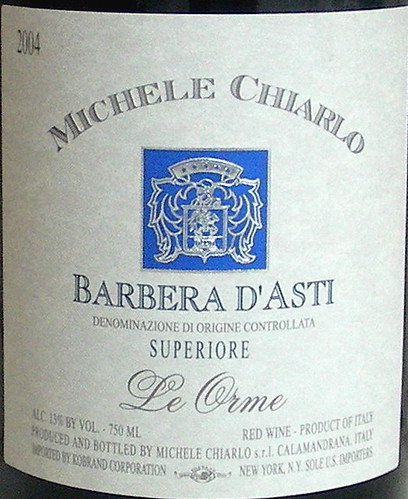 • 2004 Michele Chiarlo Barbera d'Asti Superiore Le Orme: Michele Chiarlo is a leading figure in the Italian wine industry. He is one of the first Italian producers to have introduced malolactic fermentation in Italy, in order to make more stable wines with not as much acidity and easier to drink young. The Barbera d'Asti, made from the Barbera grape, is one of his most popular wines. It had a deep red color, fruity aromas, a structured backbone and a well balanced palate with some good acidity. It was excellent to accompany a plate of prosciutto, salami, and cheese.
• 2004 Michele Chiarlo Barbera d'Asti Superiore Le Orme: Michele Chiarlo is a leading figure in the Italian wine industry. He is one of the first Italian producers to have introduced malolactic fermentation in Italy, in order to make more stable wines with not as much acidity and easier to drink young. The Barbera d'Asti, made from the Barbera grape, is one of his most popular wines. It had a deep red color, fruity aromas, a structured backbone and a well balanced palate with some good acidity. It was excellent to accompany a plate of prosciutto, salami, and cheese.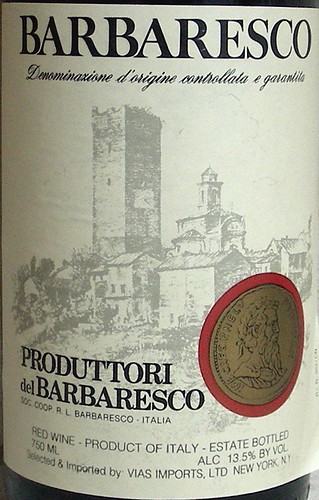 • 2002 Produttori del Barbaresco Barbaresco: Founded in the 1950s, the Produttori del Barbaresco is a cooperative that is known to produce high quality wines, and that has become a model for the other wine cooperatives in Italy. Barbaresco is a powerful wine made purely from Nebbiolo, a noble grape considered to be one of the world's greatest wine varieties. The wine had a red brick color and a powerful nose with complex aromas. The palate was rich, full-bodied, with firm tannins.
• 2002 Produttori del Barbaresco Barbaresco: Founded in the 1950s, the Produttori del Barbaresco is a cooperative that is known to produce high quality wines, and that has become a model for the other wine cooperatives in Italy. Barbaresco is a powerful wine made purely from Nebbiolo, a noble grape considered to be one of the world's greatest wine varieties. The wine had a red brick color and a powerful nose with complex aromas. The palate was rich, full-bodied, with firm tannins.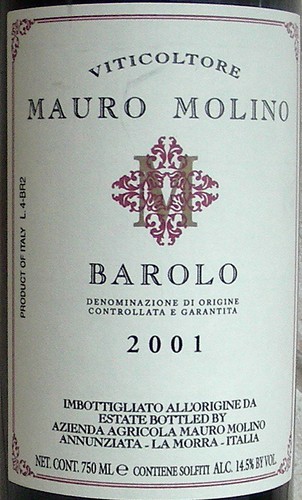 • 2001 Mauro Molino Barolo: Molino is very highly regarded producer from the village of La Morra in the Barolo Appellation. Its 8 hectare vineyard is mainly planted with Nebbiolo (60%) and also includes Barbera (20%), Dolcetto (10%), and Chardonnay (10%). Barolo, also made from Nebbiolo, is considered the most famous Piedmontese wines. This one had a ruby color and a light floral nose. The palate had intense and complex flavors and a long finish. This great wine should be paired with rich food such as beef braised in wine, wild mushroom risotto, and truffles.
• 2001 Mauro Molino Barolo: Molino is very highly regarded producer from the village of La Morra in the Barolo Appellation. Its 8 hectare vineyard is mainly planted with Nebbiolo (60%) and also includes Barbera (20%), Dolcetto (10%), and Chardonnay (10%). Barolo, also made from Nebbiolo, is considered the most famous Piedmontese wines. This one had a ruby color and a light floral nose. The palate had intense and complex flavors and a long finish. This great wine should be paired with rich food such as beef braised in wine, wild mushroom risotto, and truffles.
Our next tasting event will feature the wines of two other amazing wine regions: New Zealand and Australia, so don't miss it!
Previous wine club tastings:
• From Old World To New World
• Champagne Tasting
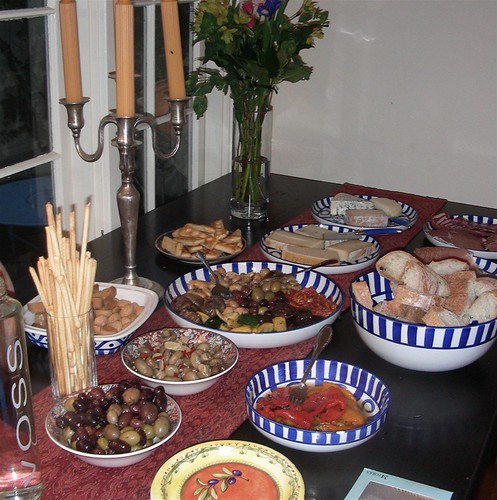
Technorati tags: wine food & drink